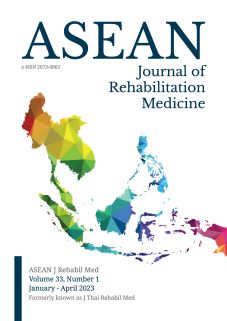Adaptation of The Stroke Driver Screening Assessment (SDSA) to Malaysian Version (MySDSA) and its Validation for Fitness to Drive after Stroke
Keywords:
driving, rehabilitation, stroke, assessmentAbstract
Objectives: To adapt the Stroke Drivers Screening Assessment (SDSA) to the Malaysian version (MySDSA) and to establish its criterion validity and predictive ability in assessing fitness to drive after a stroke in Malaysia.
Study design: A universal sampling method.
Setting: A tertiary hospital in an urban setting in Malaysia.
Subjects: Stroke survivors referred for assessment of fitness to drive.
Methods: The MySDSA was adapted from the original SDSA. An expert panel of doctors, occupational therapists, and represen-tatives from the Malaysia Road Transport Department and the Malaysia Institute of Road Safety Research was formed and a consensus decision was made to substitute all road signs in the SDSA Road Sign Recognition section with the Malaysian equivalent. No further changes to the SDSA were made, and the original English language was maintained. After that, stroke patients who had been referred for driving fitness assessment were recruited. The patients were tested using MySDSA and were classified as pass or fail using a discriminant equation. The patient’s performance on the MySDSA was then compared with their performance on a computerised driving simulator using Receiver Operating Charac-teristic (ROC) analysis. The assessor for the driving simulator was blinded from the MySDSA results.
Results: Twenty stroke survivors (mean age 50 years ±10) of the initial 35 stroke survivors recruited completed both the MySDSA and the driving simulator assessment. There was no statistically significant association between either demographic or stroke characteristics and MySDSA performance. MySDSA predicted driving performance on the simulator with 74% adjusted accuracy and above moderate effect size (Cohen’s d=0.661).
Conclusions: MySDSA has acceptable accuracy for predicting driving performance on the driving simulator test after a stroke, but it is not recommended to be used alone as a replacement for a driving simulator.
References
Aziz ZA, Lee YYL, Ngah BA, Sidek NN, Looi I, Hanip MR, et al. Acute Stroke Registry Malaysia, 2010-2014: Results from the National Neurology Registry. J Stroke Cerebrovasc Dis. 2015;24: 2701-9.
Avan A, Digaleh H, Di Napoli M, Stranges S, Behrouz R, Shojaeianbabaei G, et al. Socioeconomic status and stroke incidence, prevalence, mortality, and worldwide burden: An ecological analysis from the Global Burden of Disease Study 2017. BMC Med. 2019;17:191. doi:10.1186/s12916-019-1397-3
Legh-Smith J, Wade DT, Hewer RL. Driving after a Stroke. J R Soc Med. 2020;79:200-3.
Yu AYX, Kapral MK, Fang J, Redelmeier DA. Increased risk of traffic injury after a cerebrovascular event. Stroke. 2018;49:3006-11.
Underwood G. Understanding driving: applying cognitive psychology to a complex everyday task. Appl Cogn Psychol. 2002;16:363-5.
Fisk GD, Owsley C, Pulley LV. Driving after stroke: Driving exposure, advice, and evaluations. Arch Phys Med Rehabil. 1997;78: 1338-45.
Nouri FM, Tinson DJ, Lincoln NB. Cognitive ability and driving after stroke. Disabil Rehabil. 1987;9:110-5.
Nouri FM, Lincoln NB. Validation of a cognitive assessment: predicting driving performance after stroke. Clin Rehabil. 1992;6:275-81.
Nouri FM, Lincoln NB. Predicting driving performance after stroke. Br Med J. 1993;307:482-3.
Lincoln NB, Radford KA, Nouri FM. Stroke Drivers’ Screening Assessment European Version Revised 2016. [cited 2020 Nov 26]. Available from: https://www.nottingham.ac.uk/medicine/documents/published-assessments/sdsa-european-version-manual-2016.pdf
Lundberg C, Caneman G, Samuelsson SM, Hakamies-Blomqvist L, Almkvist O. The assessment of fitness to drive after a stroke: The Nordic Stroke Driver Screening Assessment. Scand J Psychol. 2003;44:23-30.
Selander H, Johansson K, Lundberg C, Falkmer T. The Nordic Stroke Driver Screening Assessment as predictor for the outcome of an on-road test. Scand J Occup Ther. 2010;17:10-17.
Akinwuntan AE, Gantt D, Gibson G, Kimmons K, Ross V, Rosen PN, et al. United States version of the stroke driver screening assessment: a pilot study. Top Stroke Rehabil. 2013;20:87-94.
Radford KA, Lincoln NB. Concurrent validity of the Stroke Drivers Screening Assessment. Arch Phys Med Rehabil. 2004;85:324-8.
Devos H, Akinwuntan AE, Nieuwboer A, Truijen S, Tant M, De Weerdt W. Screening for fitness to drive after stroke: a systematic review and meta-analysis. Neurology. 2011;76:747-56.
Lundberg C, Hakamies-Blomqvist L. Driving tests with older patients: Effect of unfamiliar versus famil-iar vehicle. Transp Res Part F: Traffic Psychol Behav. 2003;6:163-73.
Roalf DR, Moberg PJ, Xie SX, Wolk DA, Moelter ST, Arnold SE. Comparative accuracies of two com-mon screening instruments for classification of Alzheimer’s disease, mild cognitive impairment, and healthy aging. Alzheimers Dement. 2013;9:529-37.
Mercaldo ND, Lau KF, Zhou XH. Confidence intervals for predictive values with an emphasis to case-control studies. Stat Med. 2007;26:2170-83.
Robert HR. Epidemiology, statistics in medicine. 2nd ed. San Diego: Academic Press, 2006, p. 137-51.
Hunt BR, Kaloshin VY. Prevalence. In: Handbook of Dynamical Systems [Internet]. Amsterdam: Elsevier; 2010, Vol. 3, p. 43-87 [cited 2021 Dec 12]. Available from: https://www.ncbi.nlm.nih.gov/books/NBK430867/
Hosmer DW, Lemeshow S. Assessing the Fit of the Model - Area under the ROC curve. In: Applied lo-gistic regression [Internet]. 2nd ed. New York: John Wiley and Sons; 2000. p. 160-4. [cited 2020 Nov 10]. Available from: http://resource.heartonline.cn/20150528/1_3kOQSTg.pdf
Mandrekar JN. Receiver operating characteristic curve in diagnostic test assessment. J Thorac Oncol. 2010;5:1315-6.
Barco PP, Wallendorf MJ, Snellgrove CA, Ott BR, Carr DB. Predicting road test performance in drivers with stroke. Am J Occup Ther. 2014;68:221-9.
Lincoln NB, Radford KA. Stroke drivers’ screening assessment revised manual 2010 [Internet]. UK version. [cited 2020 Nov 26]. Available from: https://www.nottingham.ac.uk/medicine/documents/published-assessments/sdsa-manual-2016.pdf
Reed MP, Green PA. Comparison of driving performance on-road and in a low-cost simulator using a concurrent telephone dialling task. Ergonomics. 1999;42:1015-37.
Shechtman O, Classen S, Awadzi K, Mann W. Comparison of driving errors between on-the-road and simulated driving assessment: a validation study. Traffic Inj Prev. 2009;10:379-85.
Downloads
Published
How to Cite
Issue
Section
License

This work is licensed under a Creative Commons Attribution-NonCommercial-NoDerivatives 4.0 International License.






